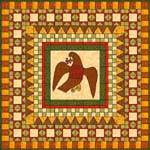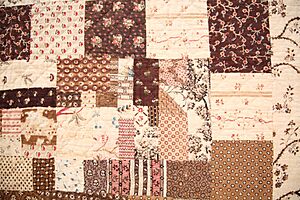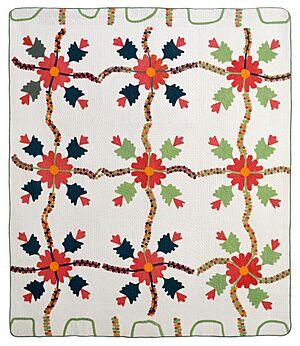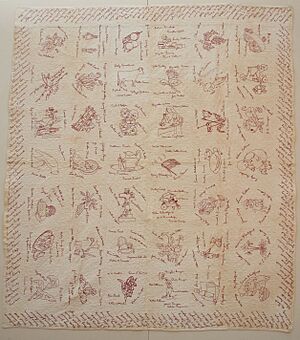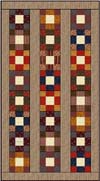History of quilting facts for kids
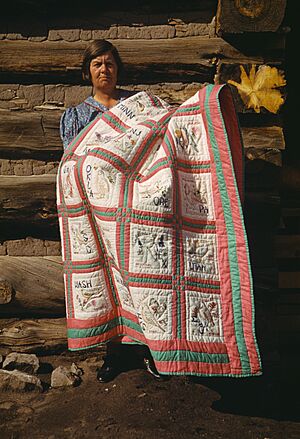
The history of quilting is all about stitching together layers of fabric and padding. This amazing craft might be as old as 3400 BCE! For a long time, quilting was mostly used to make things warm and protective. But people also added beautiful designs. Today, many quilts are seen as true pieces of art.
Contents
- Quilting Around the World
- Quilting in the United States
- See also
Quilting Around the World
Early Quilting in Europe
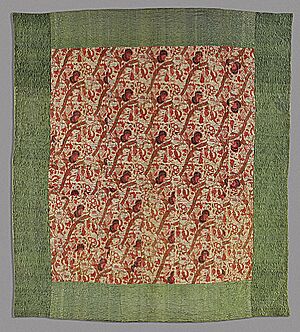
Quilting likely came to Europe around the 12th century, brought by Crusaders. They wore quilted clothes called aketons or gambesons under their armor. Later, these turned into doublets, which were a popular part of men's fashion for about 300 years.
One of the oldest fancy quilts still around is the Tristan Quilt. It was made in Sicily around 1360. Parts of it are now in the V&A Museum in London and the Bargello palace in Florence.
Ancient Quilts in Russia
The very oldest quilted item we know of is a linen carpet. It was found in a cave in Mongolia and is thought to be from between 100 BCE and 200 CE. You can see it today at the Russian Academy of Sciences in Saint Petersburg.
Quilting in the United Kingdom and Australia
The National Gallery of Australia has a huge quilt called the Rajah Quilt. It's about 3 by 3 meters (10 by 10 feet) big! About 30 women who were prisoners made it. They were being taken from England to Tasmania in Australia in 1841. This special quilt was found again in Scotland in 1989.
Quilting in the United States
Quilt making was quite common in America in the late 1600s and early 1700s. Back then, colonial quilts weren't just made from old scraps. They were often fancy items that showed off the maker's great needlework skills. Only wealthy people had enough free time to make quilts. Most people used cheaper blankets or woven coverlets to keep warm.
In the early 1800s, popular quilt styles included whole cloth quilts, broderie perse, and medallion quilts. But after 1840, quilts made from many small pieces of fabric (called piecework or blocks) became very popular. Today, quilting is a huge hobby, with millions of people enjoying it!
Wholecloth Quilts
Wholecloth quilts might look like they're made from one big piece of fabric. But early looms couldn't make cloth wide enough for a whole bed. So, these quilts were actually made from strips of the same fabric. They have three layers: a top, a filling (often wool), and a backing.
These layers were stitched together by hand before sewing machines existed. The stitches themselves were the main decoration. The first wholecloth quilts in America came from Europe. Only rich families could afford these imported quilts.
One very old quilt is at the Lovely Lane Museum in Baltimore, Maryland. It's believed to have been brought to America by the Cogswell family in 1635. Their ship was destroyed in a huge hurricane after they landed.
The Canton Historical Society in Massachusetts thinks their wholecloth quilt might be the oldest made in America. It was made in 1786 by Martha Crafts Howard. Another very old one, the Buckingham Quilt, was made around the 1660s by the wife of one of Yale University's founders.
Many beautiful wholecloth quilts that still exist have designs like feathers or flowers. Some even use a special technique called trapunto. This Italian word means adding extra stuffing to certain areas. It makes parts of the design puff out and stand up, like a raised feather or flower.
Broderie Perse Quilts
Broderie perse is a cool technique where you cut out designs from printed fabric. Then, you sew them onto a plain background. People have been doing this since the 1700s. Back then, printed fabric from India called chintz was very popular.
Printed fabric was expensive, even for well-off families. By cutting out birds, flowers, and other designs from printed fabric and sewing them onto a large plain cloth, people could make a beautiful bedspread. These special bedspreads were usually saved for the best bed or when guests came to visit.
Medallion Quilts
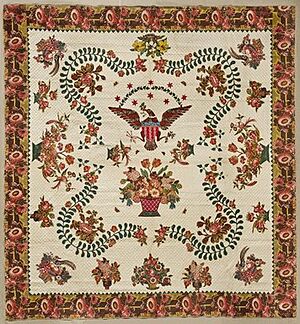
Medallion quilts are designed around a central part. This center could be a large piece of fabric with a picture, a sewn-on design, or a big star pattern. This middle part is then surrounded by two or more borders. Some borders were plain, but many had sewn-on designs or were made from many small pieces.
Mid-19th Century Quilting Changes
The Industrial Revolution brought big changes to how quilts were made in the mid-1800s. Factories started making textiles on a huge scale. This meant women didn't have to spend so much time spinning and weaving fabric for their families.
By the 1840s, factory-made fabrics were cheap enough for almost everyone. So, quilt making became very common. You could buy many different cotton prints to make clothes or even just for a quilt. While scraps were still used, it's a myth that quilts were *always* made from old clothes. Many quilts in museums were made with brand new fabric bought just for that quilt.
Another big change was in quilt styles. Before the 1840s, quilts made of many blocks were rare. But with so many fabrics available, quilters could make blocks with a wonderful variety of designs. Some block quilts had many identical blocks, while others had blocks with different patterns.
The invention of the sewing machine also helped quilt making. In 1856, the Singer company started offering payment plans, making sewing machines more affordable. By the 1870s, many homes had one. This meant women could make clothes faster, leaving more time for quilting. They could also use their machines to piece together quilt tops.
Quilts During the Civil War Era
Before and during the American Civil War, quilts were made for important reasons. Some helped raise money for the movement to end slavery. Others helped the war effort or gave warmth to soldiers. The patterns were similar to other quilts of the time, but their purpose was different.
Quilts and the Abolitionist Movement
Before 1830, people working to end slavery, called abolitionists, held big fairs to raise money and awareness. Quilts were often sold at these fairs. These were usually beautiful quilts, sometimes with anti-slavery poems or messages. The goal was to show how difficult life was for enslaved people.
There's a popular story that certain quilts were used as secret signals to help enslaved people escape to freedom on the Underground Railroad. For example, a log cabin quilt might be hung outside a safe house. However, historians don't think these stories are true. The only source for this idea is a book written over 120 years after the war. Still, the story became very popular and is found in many books and lessons today.
Quilts for the Troops
Women on both sides of the Civil War worked hard to raise money and make quilts for soldiers. In the North, quilts were still made for fairs, but now the money went to support war needs. In the South, "gunboat" quilts were made to help pay for important gunboats.
Soon, it became clear that soldiers on both sides needed blankets and quilts for warmth. In the North, women made new quilts or remade old bed coverings. Since army cots were narrow, two bedspreads could be turned into three soldier quilts. The United States Sanitary Commission helped collect and give them out.
In the South, making quilts was harder. Even though cotton was grown there, it was sent North to be made into fabric. Soon, fabric was almost impossible to get. So, women had to spin and weave their own cloth before they could sew a bed covering. Most quilts made for soldiers were simple and practical. Because they were used so much, very few of these soldier quilts have survived today.
Victorian Era Quilting in America
Quilt making stayed popular in the late 1800s. The influence of the English Victorian era was a bit delayed in the United States because of the Civil War.
Amish Quilting
Amish quilts are famous for their bold designs, unique color mixes, and amazing stitching. Quilting became a favorite activity for the Amish people after they moved to the United States and Canada from Germany and Switzerland over 250 years ago. The oldest known Amish quilts, from 1849, are whole-cloth quilts in solid colors. Quilts made from many pieces didn't appear until the 1870s.
Different Amish communities used specific patterns and fabrics. For example, before the 1940s, quilts from Lancaster County were almost always made of wool. Those made in Ohio during the same time were usually cotton.
Amish quilts often provide the only decoration in their simple homes. They were also used for guests or to show wealth. The Amish religion doesn't usually encourage showing off individual expression. But quilt making allowed Amish women to be creative without causing offense. Quilting became a big part of social life for Amish women, as it brought the community and families closer.
Quilts are made for everyday use or for special events like birthdays, weddings, or to raise money for the church. Since people outside the Amish community (called "English") discovered Amish quilts in the late 1960s, quilting has become a way for many Amish families to earn money. Their quilts are now collected all over the world.
The Crazy Quilting Fad
In the late 1800s, "Crazy quilting" became a huge trend! Crazy quilts were made from oddly shaped pieces of fabric sewn together randomly. The quilter would then add lots of embroidery. Fancy stitches were sewn along the seams, and often, embroidered designs like flowers, birds, or even a spider and web (for good luck!) were added.
Magazines encouraged people to make "crazies." These simple, artistic quilts were rarely used on beds. Instead, they were made smaller and without batting (the middle layer) to be used as decorative throws.
Traditional Quilts Still Made
Even though crazy quilting was very popular, many traditional quilts were still made for bedding and to remember special events. Simple quilts were made for everyday use. But beautiful quilts with many pieces or sewn-on designs were made for special occasions like weddings or when a beloved minister moved away. These were often very fancy.
In the 1940s and 1950s, many farm feeds came in printed sacks. These sacks had all sorts of designs. Thousands of quilts were made using these colorful feed sacks!
Contemporary Quilts
Today, quilting has grown to include many different styles. These can be useful, decorative, or artistic. Quilters are always trying new techniques and tools. Many quilters experiment with making or dyeing their own fabrics. They also use new materials and challenge what quilting can be.
New technology, like long-arm quilting machines and computer programs, has made a big difference. It has created a wider gap between modern and traditional quilting. There's a strong new interest in quilting today. Thousands of videos and tutorials about quilting are shared online. This continues the tradition of quilting as a social and artistic space where people have connected for many generations.
See also
- Duvet
- List of quilters
- NAMES Project AIDS Memorial Quilt
- Patchwork quilt
- Quilt art
- Razai
- Southern AIDS Living Quilt
- Tessellation
- Narrative quilting


